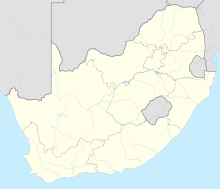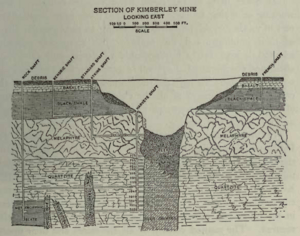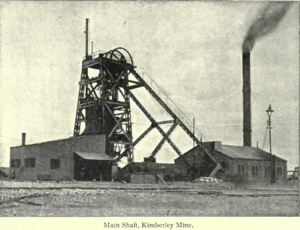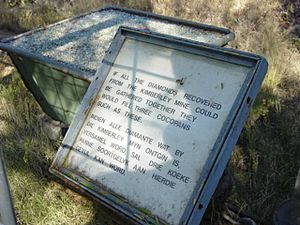Big Hole facts for kids
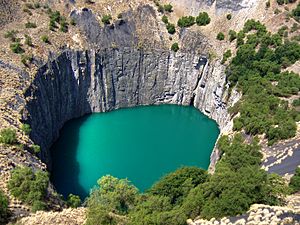
The Big Hole
|
|
| Location | |
|---|---|
| Location | Kimberley |
| Province | Northern Cape |
| Country | South Africa |
| Coordinates | 28°44′20″S 24°45′32″E / 28.73889°S 24.75889°E |
| Production | |
| Products | Diamonds |
| Type | Open-pit, underground |
| Greatest depth | 240 metres (790 ft) |
| History | |
| Opened | 1871 |
| Closed | 1914 |
| Owner | |
| Company | De Beers |
The Kimberley Mine, also known as the Big Hole, is a famous former diamond mine in Kimberley, South Africa. It is known for being one of the deepest holes ever dug by hand. This mine helped make Kimberley a very important city in the history of diamond mining.
Contents
Discovering Diamonds: The Big Hole's Beginning
The story of the Big Hole began in 1871. That year, the first diamonds were found on a small hill called Colesberg Kopje. This land belonged to the De Beers brothers. Soon, many people rushed to the area, hoping to find their own diamonds. This led to the place being called "New Rush."
Digging for Riches: How the Hole Grew
From 1871 until 1914, thousands of miners worked tirelessly. They used only picks and shovels to dig the massive hole. About 50,000 miners helped create this huge excavation. During this time, they found an amazing 2,720 kilograms of diamonds!
The Big Hole is truly enormous. Its surface covers about 17 hectares, which is like 17 football fields. It is 463 meters wide. Miners dug it down to a depth of 240 meters. Over time, some debris filled it in, making it about 215 meters deep. Today, about 40 meters of water have collected at the bottom, so you can see about 175 meters of the hole.
Mining Underground: Going Even Deeper
When it became too dangerous to dig from the surface, mining continued underground. The De Beers company, led by Cecil Rhodes, dug even deeper. They followed the diamond-rich rock, called kimberlite, down to an incredible depth of 1,097 meters below the surface.
A World Heritage Site?
Since the early 2000s, there has been an effort to make the Big Hole a World Heritage Site. This would recognize its global importance and help protect it for future generations.
Life as a Miner: Challenges and Hard Work
The discovery of diamonds brought many people to Kimberley, especially black workers. Many African men left their homes to work in the mines. This created a large population of migrant workers in the city.
Miners' Homes: Early Living Conditions
Mining companies built special housing for the miners. These areas helped keep the diamonds safe and prevent theft. However, these early living areas often lacked clean water and proper ways to get rid of waste. These conditions were part of the beginning of the apartheid city structure in South Africa.
Health Concerns: The Dangers of Mining
Working in the mines was very tough and dangerous. Between 1897 and 1899, many miners became sick. Common illnesses included lung problems like tuberculosis and pneumonia, as well as scurvy and diarrhoea. Many miners also suffered injuries from accidents. These health issues showed how difficult and unhealthy their living and working conditions were.
Mine Accidents: A Constant Threat
Accidents were a sad part of life for miners. Many were caused by falling rocks or sudden rock bursts. Accidents also happened with the trucks and tramways used to move rock, and with the cages that carried workers up and down the shafts. Miners often worked long hours at high speeds, which made accidents more likely. Newspapers from the time shared stories of these accidents and the names of the miners who died.
Coping with Fear: The Koata Strategy
Miners, especially the Basotho, developed ways to cope with the fear of working in the mines. One way was called the "Koata strategy." This involved singing, shouting, and sometimes acting unruly. It was a way to deal with the stress and danger they faced every day. This behavior was passed down through generations.
A Miner's Poem: Words from the Heart
Basotho men often saw mining as a journey into danger and even death. A poem from that time shows their feelings:
Death does not choose; famine chooses.
I was going to my mother quietly:
"Mother, take a letter for me,
I am going to DeBeers (mines)."
...
"Men gone to DeBeers.
They can come home dead from the mines."
To me, Child of Rakhali
I am not dead; even now I still live,
I am a wanderer of the mines; Sootho
Many miners who died were buried in Glastone cemetery. Records show thousands of burials for black miners, often without coffins, just wrapped in blankets. Their families were often upset by how their loved ones were treated, as traditional rituals were not respected.
The Big Hole Today: A Museum and Tourist Spot
After mining stopped in 1914, the Big Hole became a popular place for visitors. In the 1960s, people started collecting old items and buildings from Kimberley's early days. This led to the creation of a formal museum and tourist attraction.
Exploring the Past: The Mine Museum
In 1965, the De Beers company helped create an open-air museum. It showed what early Kimberley looked like, with old streets, displays of mining tools, and transport. The museum officially opened in 1971 during Kimberley's 100th birthday celebrations. One of its main attractions was the Diamond Hall.
Between 2002 and 2005, De Beers invested a lot of money to improve the Big Hole as a tourist site. The new facility, called "The Big Hole Kimberley," tells the story of "Diamonds and Destiny." It was hoped that these improvements would attract even more visitors to this historic site.
Images for kids
See also
 In Spanish: Big Hole para niños
In Spanish: Big Hole para niños
- Blood Diamond
- Kimberley Process Certification Scheme
- Koffiefontein mine


